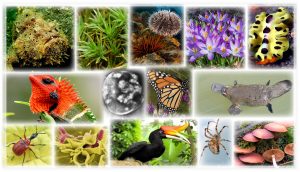7 Biodiversity
Andrea Bierema

Learning Objectives
Students will be able to:
- Define biodiversity.
- Use visual models to characterize the scope of biodiversity on earth.
- Describe efforts to conserve threatened and endangered species.
- Explain the Red List of Threatened Species.
- Recognize types of protected areas.
- Describe the benefits of biodiversity.
- Characterize the threats to biodiversity.
- Explain ways in which organizations are working to save biodiversity.
Introduction to Biodiversity
Earth’s biodiversity includes the entire range of living species, including single-celled and multicellular organisms. View the following interactive video to learn more!
The previous video showed how to measure biodiversity and examples of how the amount of biodiversity varies throughout the world. Another aspect of biodiversity is that it is studied at different levels:
The relationship between species, genetic, and ecosystem diversities is complex and interdependent. That is, a species cannot exist without genetic diversity or ecosystem diversity and vice versa. For that reason, it is virtually impossible to affect one aspect of diversity without affecting the other. We can, therefore, think of species, genetic, and ecosystem diversities simply as different ways to measure the variety of life.
Let’s dive deeper into ecosystem biodiversity:
Benefits of Biodiversity
How do humans benefit from biodiversity? Watch the interactive video to find out!
Threats to Biodiversity
Despite humans obtaining several benefits from high biodiversity, there are several things that we are doing that limit biodiversity.
Saving Biodiversity
Although many of our actions threaten biodiversity, there are things that people are doing to minimize our impact and save biodiversity.
Species Richness and Threat Level Comparison
The following is a series of maps illustrating global species richness as well as the number of threatened species for various taxa. Slide the white vertical line to see the threatened species map and to compare the two maps.
Terrestrial Species
Marine Species
Discussion Question
How do the species-richness and threatened-species maps compare? Are there consistent trends across the different taxa? Why do you think these patterns or lack of patterns exist?
Attributions
The maps in this chapter are from “Biodiversity Mapping” by Jenkins, C. N. Used with permission.
This chapter is a modified derivative of “What is Biodiversity?” by Wilson, J. W., & Primack, R. B., Conservation Biology in Sub-Saharan Africa, Cambridge, UK, Open Book Publishers, 2019.
Figure 1 Attributions
(in order from left to right, starting in row 1)
“Antennarius pictus- Painted frogfish” by Steve Childs is licensed under CC BY 2.0.
“Aloe-moss (Polytrichaceae) at Philip Edward Island in Killarney, Ontario, Canada” by Ryan Hodnett is licensed under CC BY-SA 4.0.
“Tripneustes ventricosus (West Indian sea egg-top) and Echinometra viridis (reef urchin – bottom)” by Nick Hobgood is licensed under CC BY-SA 3.0.
“Flowering woodland crocus in the garden reserve Jonkervallei, Joure, Netherlands” by Dominicus Johannes Bergsma is licensed under CC BY-SA 4.0.
“Lembeh, Indonesia – flatworm – Eurylepta sp.” by Rickard Zerpe is licensed under CC BY-SA 2.0.
“The alien lizard” by Kalablink is licensed under CC BY-SA 4.0.
“Sulfolobus infected with the DNA virus STSV1” by Xiangyux is licensed under Public Domain.
“Monarch butterfly (Danaus plexippus) in Brooklyn Botanic Garden” by Rhododendrites is licensed under CC BY-SA 4.0.
“Feeding platypus” by Brisbane City Council is licensed under CC BY 2.0.
“Apoderus coryli” by @entomart who allows anyone to use it for any purpose, provided that the copyright holder is properly attributed.
“SalmonellaNIAID” by NIIAID is licensed under Public Domain.
“Hornbill exotic bird background” by Alok Sahil is licensed under CC BY SA 4.0.
“Underside of a English garden spider (Araneus diadematus) in its web” by Michael Gabler is licensed under CC BY SA 3.0.
“Galerina marginata” by Eric Steinert is licensed under GNU Free Documentation License, Version 1.2.
Media Attributions
- Biodiversity Collage © Andrea Bierema

